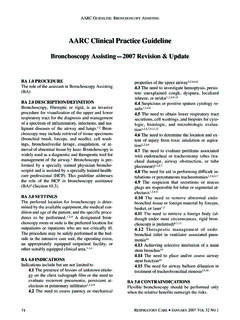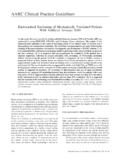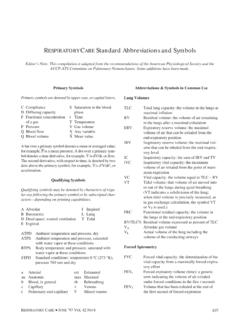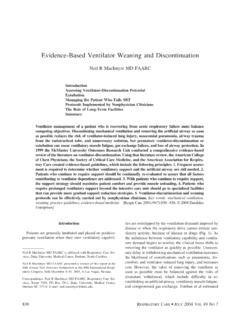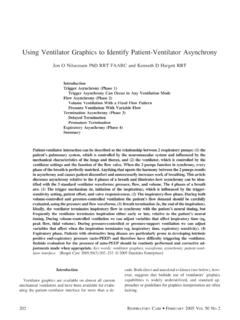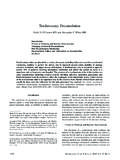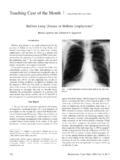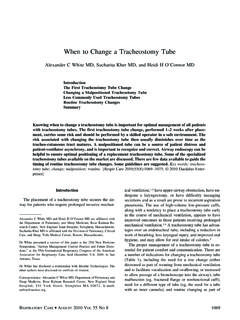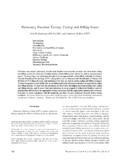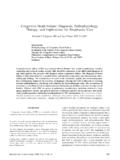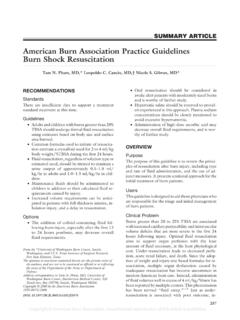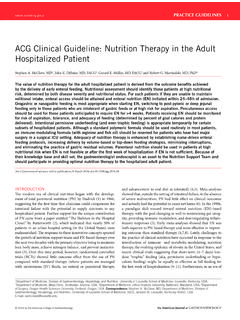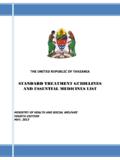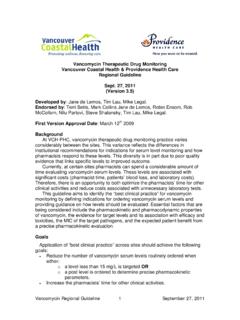Transcription of AARC Evidence-Based Clinical Practice Guidelines
1 AARC Evidence-Based Clinical Practice GuidelinesCare of the Ventilator Circuitand Its Relation to Ventilator-Associated PneumoniaSummary of Recommendations Ventilator circuits should not be changed routinely for infection control purposes. The maximumduration of time that circuits can be used safely is unknown. evidence is lacking related to ventilator-associated pneumonia (VAP) and issues of heated versusunheated circuits, type of heated humidifier, method for filling the humidifier, and technique forclearing condensate from the ventilator circuit. Although the available evidence suggests a lower VAP rate with passive humidification than withactive humidification, other issues related to the use of passive humidifiers (resistance, dead spacevolume, airway occlusion risk) preclude a recommendation for the general use of passive humidifiers.
2 Passive humidifiers do not need to be changed daily for reasons of infection control or technicalperformance. They can be safely used for at least 48 hours, and with some patient populationssome devices may be able to be used for periods of up to 1 week. The use of closed suction catheters should be considered part of a VAP prevention strategy, andthey do not need to be changed daily for infection control purposes. The maximum duration oftime that closed suction catheters can be used safely is unknown. Clinicians caring for mechanically ventilated patients should be aware of risk factors for VAP (eg,nebulizer therapy, manual ventilation, and patient transport).
3 [Respir Care 2003;48(9):869 879. 2003 Daedalus Enterprises]IntroductionA concern related to the care of the mechanically ven-tilated patient is the development of VAP. For many yearsthis concern focused on the ventilator circuit and humid-ifier. Accordingly, the circuit and humidifier have beenchanged on a regular basis in an attempt to decrease theVAP rate. However, as the evidence evolved, it becameapparent that the origin of VAP is more likely from sitesother than the ventilator circuit,1,2and thus the prevailingpractice has become one of changing circuits less this Practice is safe, it will offer substantialcost savings.
4 Other issues related to the components of thecircuit and VAP have also become more important re-cently. For example, humidification systems can be eitheractive or passive. Increasingly, inline suction is used, andthis becomes part of the ventilator systematic review of the literature was conductedwith the intention of making recommendations for changefrequency of the ventilator circuit and additional compo-nents of the circuit. Specifically, the Writing Committeewrote these Evidence-Based Clinical Practice Guidelines toaddress the following questions:1. Do ventilator circuits need to be changed at regularintervals:a. For infection control purposes?
5 B. Because of deterioration in performance?2. What is the economic impact of decreasing the fre-quency of ventilator circuit changes?3. What are the issues related to circuit type?a. Disposable versus reusableb. Cleaning techniquesc. Site of care (acute care, long-term care, home care)4. Does the choice of active versus passive humidificationaffect ventilator circuit change frequency?5. Do passive humidifiers need to be changed at regularintervals:a. For infection control purposes?b. Because of deterioration in performance?Principal author: Dean R Hess PhD RRT committee:Thomas J Kallstrom RRT FAARC, Carl D Mottram RRT FAARC, Tim-othy R Myers RRT-NPS, Helen M Sorenson MA RRT FAARC, andDavid L Vines MHS : Dean R Hess PhD RRT FAARC, Respiratory Care,Ellison 401, Massachusetts General Hospital, 55 Fruit Street, Boston MA02114.
6 E-mail: SEPTEMBER2003 VOL48 NO98696. Do in-line suction catheters need to be changed at reg-ular intervals:a. For infection control purposes?b. Because of deterioration in performance?7. Are there specific populations for which the recom-mendations should be altered?a. Differences for age groups (neonatal, pediatric, adult)b. Differences for site of care (acute care, long-termcare, home care)c. Differences for categories of patients (immunocom-promised, burn)MethodsTo identify the evidence for addressing these questions,a PubMed (MEDLINE) search was conducted using thefollowing search terms: pneumonia AND mechanical ven-tilation, humidifier, ventilator circuit, heated circuit, suc-tion catheter, endotracheal suction, closed suction catheter,respiratory therapy equipment, endotracheal intubation,heat and moisture exchanger, tracheostomy, respiratorycare, equipment contamination, equipment disinfection, ar-tificial ventilation.
7 The search was confined to human stud-ies published in the English language. References and ab-stracts were retrieved into reference management software(EndNote, ISI, Berkeley, California). By inspection of thesetitles, references having no relevance to the study ques-tions were eliminated. For the titles that remained, theabstracts were assessed for relevance and additional ref-erences were eliminated as appropriate. This process wasconducted independently by 2 individuals, after which theirreference lists were merged to provide the reference basefor further analysis. Throughout the process of developingthese Guidelines , members of the Writing Committee sur-veyed cross-references to identify additional references tobe added to the reference base for were extracted from selected references using astandardized critique form.
8 To validate this form and toestablish the reliability of the review process, several ref-erences were evaluated by the entire committee during aface-to-face meeting. All references were then indepen-dently examined by at least 2 members of the WritingCommittee. The critiques were compared and differenceswere resolved using an iterative process. All referenceswere graded according to the following scheme:Level 1: Randomized,controlledtrialwithstatistica llysig-nificant resultsLevel 2:Randomized, controlled trial with significantthreats to validity (eg, small sample size, inap-propriate blinding, weak methodology)Level 3: Observational study with a concurrent controlgroupLevel 4:Observational study with a historical controlgroupLevel 5.
9 Bench study, animal study, case seriesThe critique forms were submitted to the principal au-thor of the guideline (DRH), who transferred the informa-tion into evidence tables and conducted appropriate statis-tical analysis consisted of meta-analysis and pe-tograms. Statistical analysis was conducted using RevMansoftware (RevMan Analyses, Version for Windows, inReview Manager [RevMan] , Oxford, England: TheCochrane Collaboration, 2003). Relative risk was calcu-lated using a random effect model. P was consid-ered statistically significant. Following a systematic re-view of the literature, recommendations were drafted bythe Writing Committee and assigned one of the followinggrades, based on the strength of the evidence :Grade A:Scientificevidenceprovidedbyrandomized ,well-designed, well-conducted, controlledtrialswithstatisticallysignifi cantresultsthatconsistently support the guideline recom-mendation; supported by Level 1 or 2 evi-denceGrade B: Scientific evidence provided by well-de-signed, well-conducted observational studieswith statistically significant results that con-sistently support the guideline recommenda-tion.
10 Supported by Level 3 or 4 evidenceGrade C: Scientific evidence from bench studies, ani-mal studies, case studies; supported by Level5 evidenceGrade D: Expertopinionprovidesthebasisfortheguide -line recommendation, but scientific evidenceeither provided inconsistent results or waslackingThe draft document was then reviewed by experts onventilator circuit care. Each of the reviewer s commentswas carefully assessed and the document was further re-vised as Ventilator Circuits Need to Be Changed atRegular Intervals? based on studies published in the 1960s that showed anassociation between respiratory equipment and nosoco-mial pneumonia,4,5the Practice of changing ventilator cir-cuits at least daily was established.
